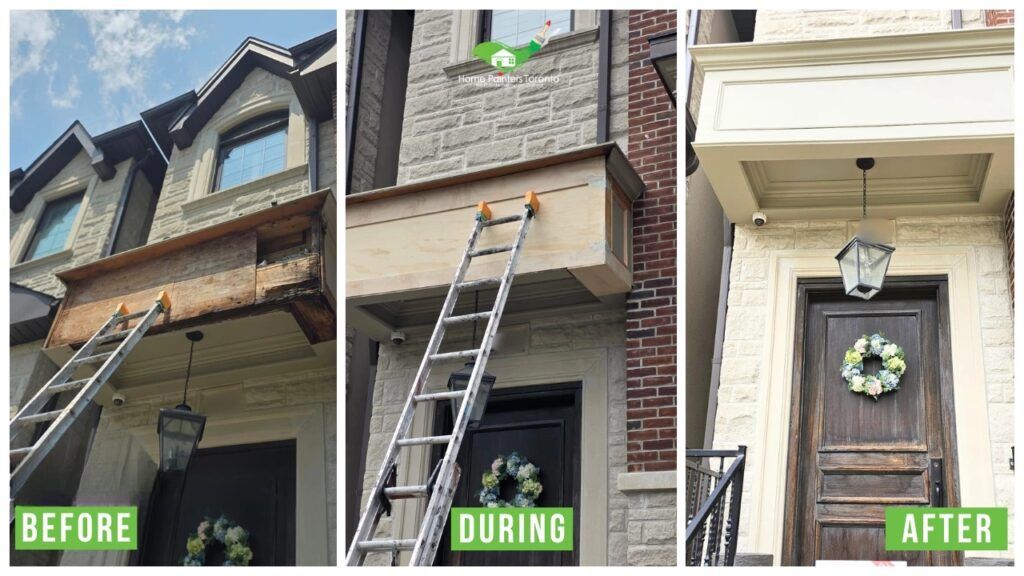Have you noticed soft, cracked, or crumbling wood around your windows, porch, or trim? That could be wood rot, a common issue in many Toronto homes, especially after long wet seasons.
Wood rot can sneak up quietly, but when left unchecked, it can cause real damage. In this post, we’ll explore what wood rot is, how to find it, how to repair it, and when it might be time to call in help.
What Is Wood Rot and Why Should You Worry?
Wood rot is a type of fungal decay that eats away at wood that has been exposed to excess moisture for too long. There are two main types: dry rot and wet rot. Despite the name, both types need moisture to grow.
Dry rot spreads faster and can be more destructive, often traveling through hidden areas behind walls. Wet rot, on the other hand, stays near the moisture source but still weakens the wood, making it soft and unsafe.
Why is this a big deal? Because rotting wood isn’t just ugly. It can weaken structures and lead to bigger problems like mould, pest infestations, or even major home repairs.
Why Toronto Homes Are at Risk
Toronto’s changing seasons, with heavy rains, snow, and freeze-thaw cycles, create ideal conditions for rot to start. Older homes, especially those with wooden siding, trim, or porches, are even more prone to rot if they’re not properly sealed or maintained.
If you live in the city or GTA, it’s a good idea to inspect your home regularly for signs of water damage and decay.
Signs of Wood Rot in Toronto Homes
Not sure if you’re dealing with wood rot? Here are a few signs to look for:
- Soft or spongey texture: Press the wood gently with your finger or a screwdriver. If it feels soft, springy, or gives easily, that’s a red flag.
- Cracked or flaking wood: If pieces are falling off or breaking apart with minimal effort, that’s a sign the structure is compromised.
- Peeling paint or bubbling finish: Moisture trapped underneath the paint can signal decay underneath.
- Musty or damp smell: Wood rot often brings a distinct earthy or moldy smell, especially around windows, decks, and doors.
- Discolouration: Wood that looks darker than the rest of the structure or has grey, yellow, or greenish patches may be affected by fungi.
Pro tip: Even if the surface looks fine, don’t assume everything underneath is. Wood rot often hides behind paint or siding.
Common Places Wood Rot Hides
Rot tends to show up in areas where moisture collects or ventilation is poor. In Toronto homes, these spots are especially common:
1. Window Sills and Frames
These areas catch water from rain, snow, and melting ice. If the caulking is cracked or paint is peeling, water can easily seep in.
2. Deck Boards and Railings
Outdoor wood surfaces take the full brunt of the weather. Without proper sealing or drainage, moisture gets trapped.
3. Eaves, Fascia, and Soffits
These overhanging edges of your roof are meant to protect your home, but only if they’re intact. A missing shingle or a clogged gutter can let water flow right into the wood.
4. Porch Posts and Steps
Older porches often use untreated or poorly treated wood, which absorbs water easily from below.
5. Wooden Siding or Trim
Even painted or stained siding can fail over time. Cracks, warping, or soft spots are signs it’s time to inspect more closely.
Checking these areas regularly, especially in the spring and fall, can help you catch issues early before they spread.
How to Do Basic Wood Rot Repair (DIY)
For smaller spots, you might be able to handle wood rot repair on your own. Here’s how:
Step 1: Check the Extent of the Damage
Use a flathead screwdriver or utility knife to poke into the wood. If the damage is only on the surface, you might be able to save it. If it goes deeper, full replacement may be needed.
Step 2: Remove the Rotted Wood
Cut or chisel out the rotted areas until you hit solid, healthy wood. Don’t leave any soft parts behind, or the rot will return.
Step 3: Treat the Area
Use a wood hardener or rot treatment product to protect the remaining wood. These sealants kill remaining fungi and strengthen the wood fibers.
Step 4: Fill or Replace
Small gaps can be filled with an exterior-grade wood filler or epoxy. For larger sections, it’s better to replace the entire board or trim.
Step 5: Sand and Paint
Once dry, sand the surface smooth and apply a weather-resistant primer and two coats of paint or stain to seal it properly.
When to Call a Pro for Wood Rot Repair
There are times when DIY just won’t cut it. If the rotted area is high up (like second-story window trim), near electrical components, or affecting a large structure like a porch or support beam, it’s best to call a professional.
Experienced contractors have the tools, safety gear, and knowledge to inspect, diagnose, and fully repair the problem, sometimes before it even shows up on the surface.
This is especially important in older Toronto homes, where original wood features can be hard to match and require careful restoration.
Professionals can also advise on how to prevent future damage through sealing, proper paint choices, gutter adjustments, and ventilation upgrades.
Prevention Tips: Keep Wood Rot From Coming Back
Repairing wood rot is only half the job. Keeping it from coming back is just as important. Here are some simple ways to protect your home:
- Keep gutters and downspouts clear. Water should flow away from your home, not into it.
- Inspect caulking around windows and doors. Replace any that’s cracked or missing.
- Use high-quality exterior paint or stain. This acts as a moisture barrier.
- Fix roof leaks fast. Even small ones can cause major rot over time.
- Ensure proper ventilation. Good airflow keeps surfaces dry, especially in attics and crawlspaces.
By staying proactive, you’ll extend the life of your home’s wood features—and save on repair costs later.
Stop Wood Rot Before It Spreads
If you own a home in Toronto, wood rot is something you’ll likely face at some point. But with regular checks and quick action, you can stop it before it spreads.
For small jobs, wood rot repair can be done with basic tools and a little know-how. But for anything complex or hard to reach, calling a pro will ensure it’s fixed safely and permanently.
And if you’re unsure where to start, getting an expert opinion is never a bad idea. Whether it’s treating rot, replacing wood, or repainting damaged areas, a solid repair today means peace of mind tomorrow.
Feature Image courtesy of Home Painters Toronto

























